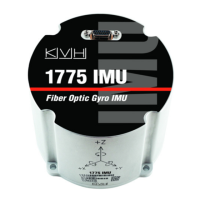This document contains proprietary information of KVH Industries, Inc. and neither this document nor said proprietary information shall be
published, reproduced, copied, disclosed, or used for any purpose without the express written permission of a duly authorized KVH representative.
Page 39 of 77
8.16 =filttype
8.16.1 Description
This command sets the type of low pass filter being used in the final output of data to one of
the built-in types. It can be used to specify a Chebyshev filter (actually a Chebyshev type II or
inverse Chebyshev), Butterworth filter, or a Uniform Averager. The command acts
independently on the accelerometer and gyro filters, so each must be specified as a separate
command. Command syntax usage varies according to the type of low pass filter chosen.
When specifying the Butterworth or Chebyshev types without additional parameters, the
default will be used as 8th order, unity gain and the cutoff frequencies will be adjusted
automatically according to the existing data rate command. In the 1775 IMU, additional
optional parameters may be used to provide some semi-customization without having to fully
design a custom filter. The filter coefficients will be recomputed to default (not semi-custom)
conditions if the data rate is subsequently changed with the =DR command. Therefore, when
using the semi-custom filter options, the data rate should be set as desired prior to the
=FILTTYPE command.
Selection of the Uniform Averager type low-pass filter results in accumulation of data followed
by averaging over the output period (i.e., it is not a moving average). This filter type is
automatically selected as the default when the unit is configured for external output rate control
(=MSYNC,EXT command) operation. The period of average will be based on the ratio of input
sampling rate to output sampling rate where input sampling rate is controlled by the data rate
command according to the sample rate in Table 8-1.
After setting filter type for Butterworth or Chebyshev, the ?FC20 command can be used to read
back the coefficients in use. Also, the =TESTFILT command can be used to get the impulse
response. This is not true for the Uniform Averager type since it does not affect the biquad
stage coefficients.
Some optional parameters, if invalid, may result in a warning about usage and others may
result in undefined behavior. For example, cutoff frequencies above the Nyquist ratio of a
filter’s input sample rate (output cutoff frequency/internal sample rate >= 0.5) may be
accepted. However, in this case, the filter coefficients should result in an all pass filter without
any warning or error (see the =FC20 command for table of internal sample rates).
NOTE: As with all commands, users should not assume that the existing behavior of undefined or out of range
parameters will be the same in future software versions.
There is no way to specify the filter type as a true custom eight-order filter with this command.
However, simply using the =FC20 command with user-defined filter coefficients (see the =FC
command description for details) automatically switches the filter type to custom, so the
?FILTTYPE query may return type custom.

